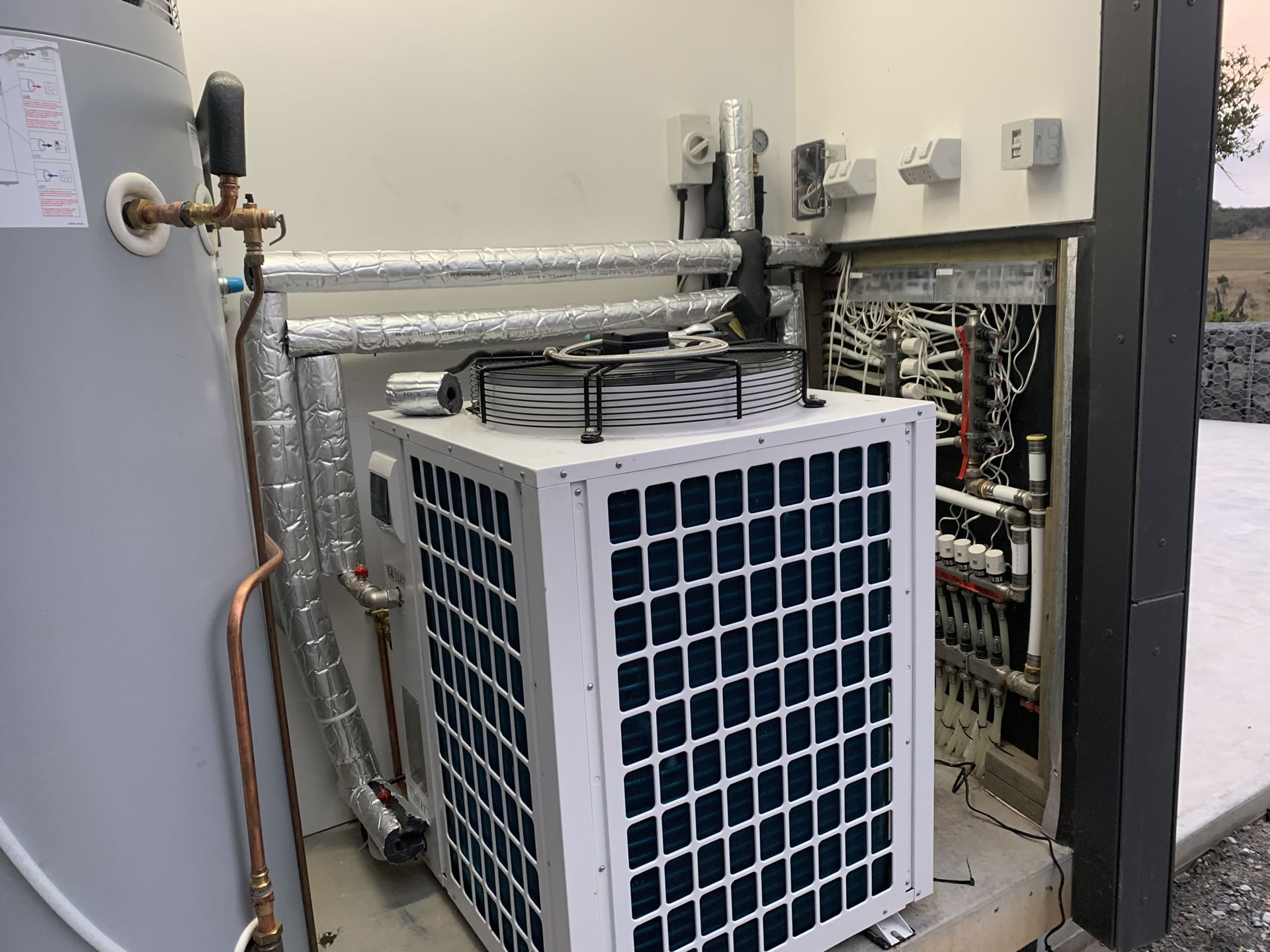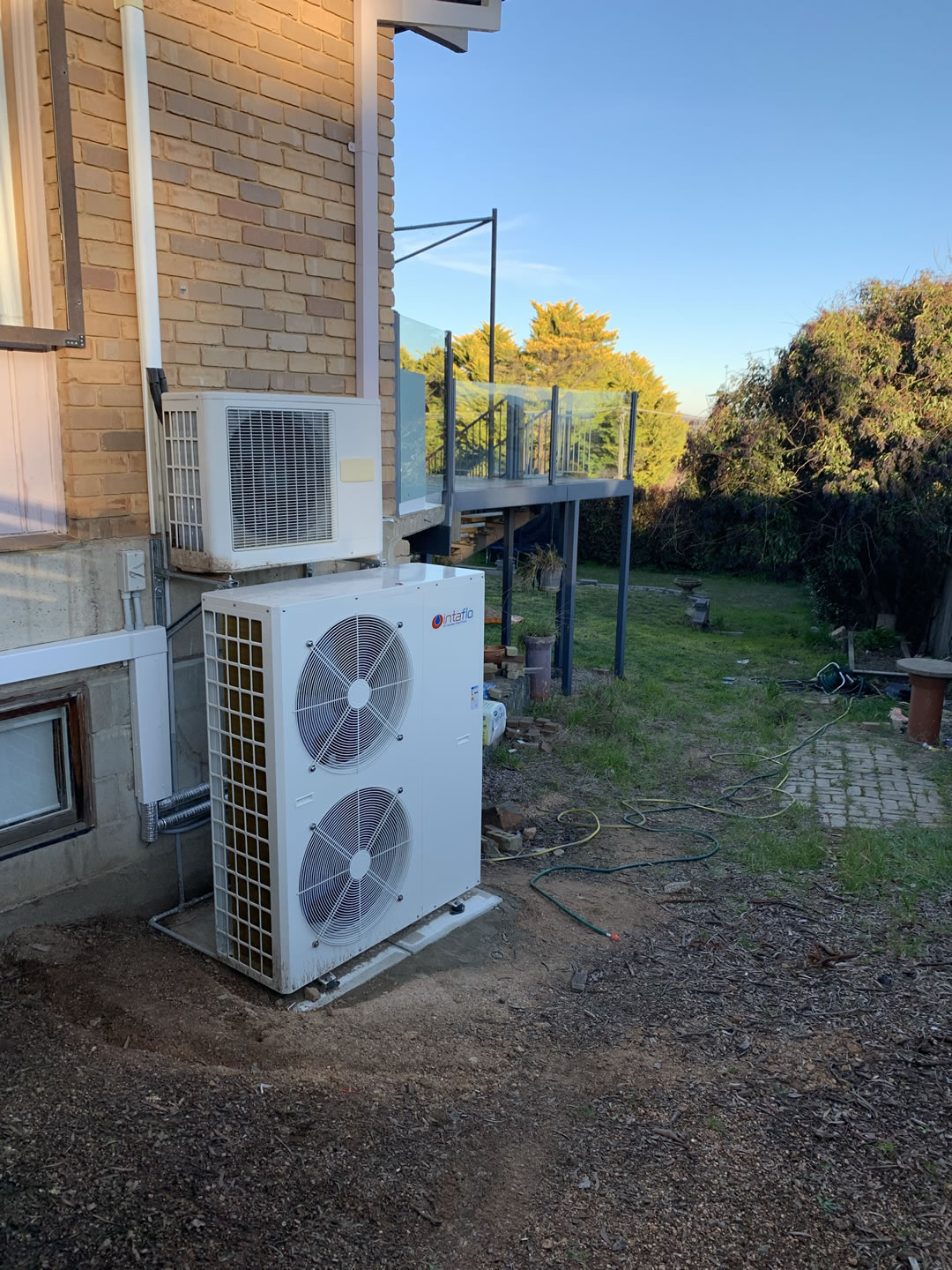HEAT PUMP
Converting from Gas Boiler to Heat Pump

Why switch to a heat pump?
I would not recommend simply removing a working condensing gas boiler, that is not ready to be replaced, waiting for reliability issues, or is time for a replacement.
Heat pumps are a good option for hydronic heating, particularly for in-slab. They are extremely energy efficient, 1kwh input produces around 4.6kwh output of energy, known as the COP (Co-efficient of Performance).
Compared to a high-efficiency gas boiler 1kwh input only produces 0.9kwh output.
With solar PV panels on the house, you can further reduce running costs significantly.
Types of Heat pump
- Hydronic heat pumps are known as air-to-water.
- Air-conditioning heat pumps are known as air-to-air.
- Ground source (or Geothermal) heat pumps are water to water but in Australia, it’s unlikely to be economically viable.
Factors Affecting Heat Pump Output
The performance of heat pumps can be influenced by several factors:
- Ambient air temperature,
- Water temperature input,
- Water temperature output.
Heat Pump Output Capacity
Heat pump size for hydronic heating is based on the industry standard in Australia, which considers:
- Outside air temperature: 7°C
- Water inlet temperature: 30°C
- Water outlet temperature: 35°C
Changing any of these metrics will affect output. For instance the following will reduce the capacity of the heat pump.
- Higher water outlet temperature,
- Lower air temperature, or
- Lower water inlet temperature.
Conversely, a higher ambient air temperature will increase output.
Energy Cost Comparison in Canberra, Australia
In Canberra, natural gas is about half the price of electricity. However, the efficiency of heating technologies varies significantly:
- A highly efficient gas boiler operates at about 90% efficiency (older models may be less than 70% efficient).
- A heat pump, on the other hand, can achieve around 450% efficiency.
Cost to Produce 10 kWh of Energy (Using 2024 Prices):
- Natural Gas costs approximately $0.135 per kWh.
- Electricity costs $0.28 per kWh.
- Using a heat pump: $0.622 to generate 10 kWh
- Using an older gas boiler: $1.93 to generate 10 kWh
Solar: Greater savings are achieved for those who have PV panels to offset electricity costs, which should be considered in the overall cost analysis.
Heat Pump Sizing Guide
Use our online calculator below to determine the cost savings and appropriate sizing for a heat pump based on your specific needs:
From your gas bill, either input the dollar value, or the gas units in Megajoules consumed.
Gas usage $
Input two variables
Annual gas cost $
Winter Gas cost $
(Less) Summer cost $
Cost per MJ (required)
Total kWh for winter heating
OR
Gas Usage MJ
Input two variables
Annual gas usage MJ
Winter Usage MJ
(Less) Summer Usage MJ
Cost per MJ (required)
Total kWh for Winter heating
Boiler Efficiency
Heat Pump equivalent running costs
Cost per kWh
Actual heat generated from HP (kWh)
kWh consumed HP using COP 4.5
Estimated running costs
Solar PV installed
If Solar PV is installed, this could significantly increase savings
Savings $
Savings %
A Rough Guide to Estimate Heat Pump Size for Your New Home
Inslab Heating:
- Well-insulated concrete slab and house with zoning: Use 70 watts per square meter in a temperate climate.
Example: For a 200m² house, a 14kW heat pump is recommended. - Average insulated slab and house, with few zones: Use 100 watts per square meter in a temperate climate.
Example: For a 200m² house, a 20kW heat pump is recommended.
Radiators:
- Well-insulated home and zones, with oversized radiators: Use 100 watts per square meter.
Example: For a 200m² home, a 20kW heat pump is recommended. - Average insulated home: Use 120 – 150 watts per square meter.
Example: For a 200m² home, estimate a 24 – 30kW heat pump.
Ideal heat pump position
Understanding the geography to place the heatpump is important for the efficient heatpump operation.
- Placing your heat pump on the north side (southern hemisphere) of the house to gain the winter sun, in our experience, seems to make a difference in the heat pump’s performance during winter.
- Away from bedrooms particularly bedroom windows..
- Allow for plenty of airflow all around, particularly in front.
- Allow for servicing and warranty access.
- Those in snow areas, mount up from the ground and top cover but still allow plenty of airflow.
Also, heat pumps may allow for cooling the slab during summer, which can be tricky see - Hydronic Cooling.
All our clients with automation use the cooling option, as it's no extra cost, and cooling the slab to say 20 degrees on a 35-degree day, has a significant effect on the comfort level within the home.
Zoning - Control and monitoring
Zoning and automation improve the efficiency and control of your hydronic system, particularly for heat pumps.
Heat pumps are sized to the house heating requirements, with gas boilers size does not come into play generally.
A gas boiler generally operates at similar efficiencies regardless of outside air temperature for in-slab heating. More information: See the page on Zoning.

